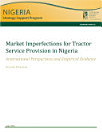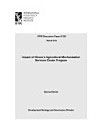Protected agriculture, precision agriculture, and vertical farming: Brief reviews of issues in the literature focusing on the developing region in Asia
Takeshima, Hiroyuki · Joshi, Pramod Kumar
thg 3 2019 · IFPRI Discussion Paper Sách 1814 · Intl Food Policy Res Inst
3,0star
2 bài đánh giáreport
Sách điện tử
49
Trang
family_home
Đủ điều kiện
info
reportĐiểm xếp hạng và bài đánh giá chưa được xác minh Tìm hiểu thêm
Giới thiệu về sách điện tử này
The frontiers of technologies have been constantly expanded in many industries around the world, including the agricultural sector. Among many “frontier technologies” in agriculture, are protected agriculture, precision agriculture, and vertical farming, all of which depart substantially from many conventional agricultural production methods. It is not yet clear how these technologies can become adoptable in developing countries, including, for example, South Asian countries like India. This paper briefly reviews the issues associated withthese three types of frontier technologies. We do so by systematically checkingthe academic articleslisted in Google Scholar, which primarily focus on these technologies in developing countries in Asia. Where appropriate, a few widely-cited overview articles for each technology were also reviewed. The findings generally reveal where performances of these technologiescan be raised potentially, based on the general trends in the literature. Where evidence is rich, some generalizable economic insights about these technologies are provided. For protected agriculture, recent research has focusedsignificantly on various features of protective structures (tunnel heights, covering materials, shading structures, frames and sizes) indicating that there are potentials for adaptive research on such structures to raise the productivity of protected agriculture. The research on protected agriculture also focuses on types of climate parameters controlled, andenergy structures, among others. For precision agriculture, recent research has focused on the spatial variability of production environments, development of efficient and suitable data management systems, efficiency of various types of image analyses and optical sensing, efficiency of sensors and related technologies, designs of precision agriculture equipment, optimal inputs and service uses, and their spatial allocations, potentials of unmanned aerial vehicles (UAVs) and nano-technologies. For vertical farming, research has often highlighted the variations in technologies based on out-door / indoor systems, ways to improve plants’ access to light (natural or artificial), growing medium and nutrient / water supply, advanced features like electricity generation and integration of production space into an office / residential space, and water treatment. For India, issues listed above may be some of the key areas that the country can draw on from other more advanced countries in Asia, or can focus in its adaptive research to improve the relevance and applicability of these technologies to the country.
Xếp hạng và đánh giá
3,0
2 bài đánh giá
Giới thiệu tác giả
Xếp hạng sách điện tử này
Cho chúng tôi biết suy nghĩ của bạn.
Đọc thông tin
Điện thoại thông minh và máy tính bảng
Cài đặt ứng dụng Google Play Sách cho Android và iPad/iPhone. Ứng dụng sẽ tự động đồng bộ hóa với tài khoản của bạn và cho phép bạn đọc trực tuyến hoặc ngoại tuyến dù cho bạn ở đâu.
Máy tính xách tay và máy tính
Bạn có thể nghe các sách nói đã mua trên Google Play thông qua trình duyệt web trên máy tính.
Thiết bị đọc sách điện tử và các thiết bị khác
Để đọc trên thiết bị e-ink như máy đọc sách điện tử Kobo, bạn sẽ cần tải tệp xuống và chuyển tệp đó sang thiết bị của mình. Hãy làm theo hướng dẫn chi tiết trong Trung tâm trợ giúp để chuyển tệp sang máy đọc sách điện tử được hỗ trợ.










